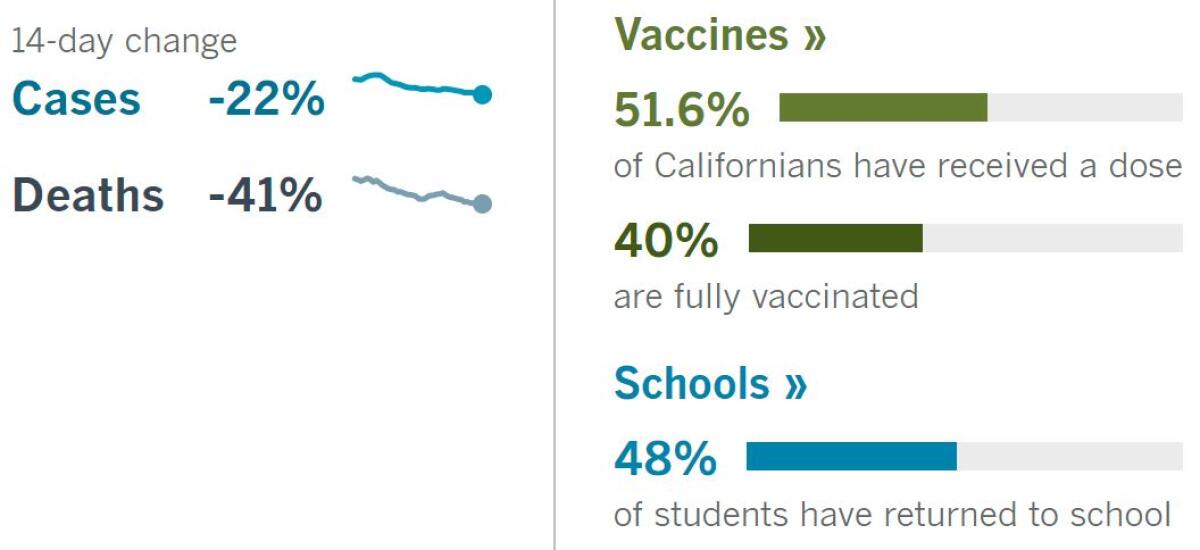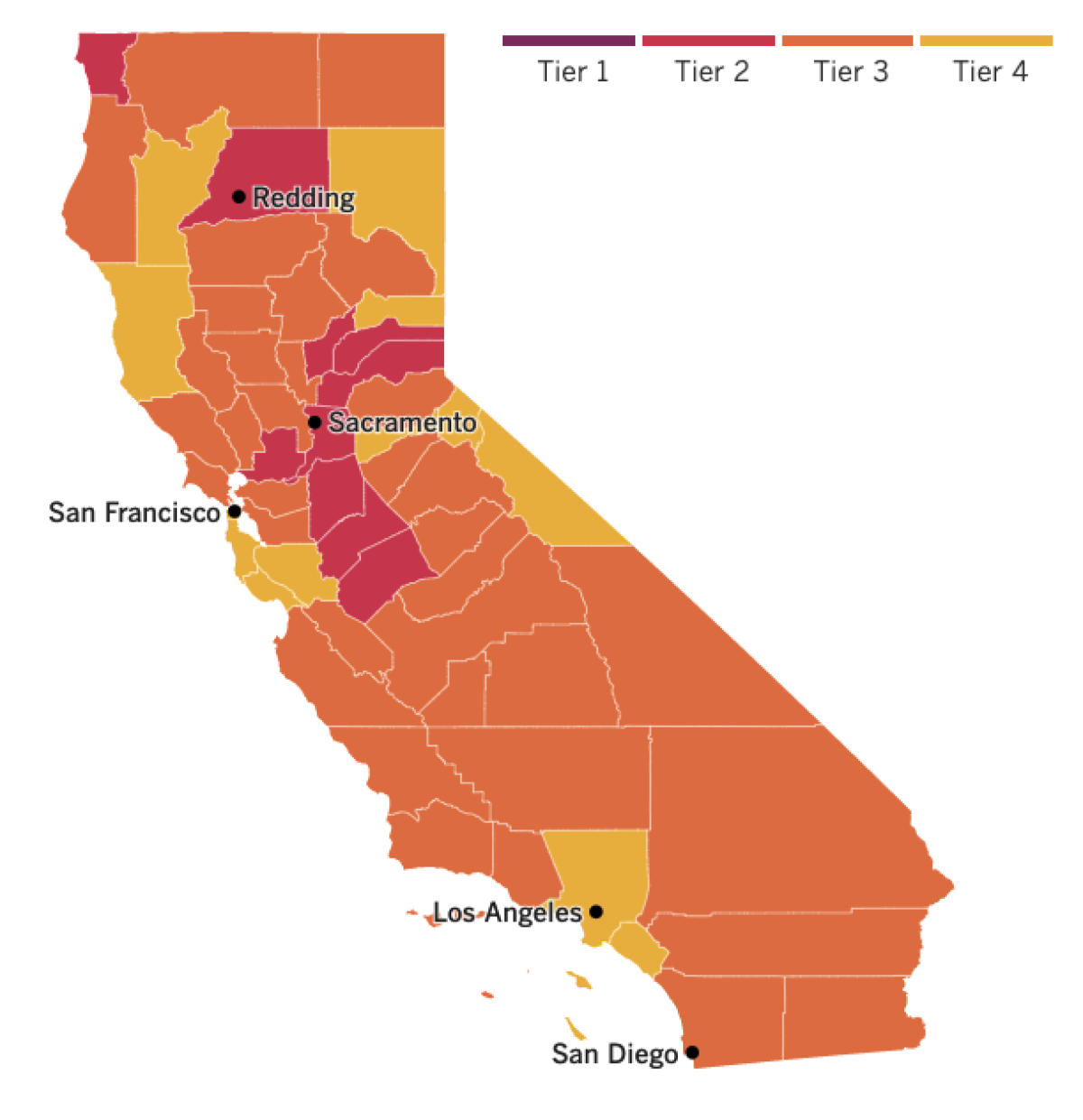Coronavirus Today: Will COVID-19 change work for the better?
Good evening. I’m Kiera Feldman, and it’s Wednesday, May 19. Here’s what’s happening with the coronavirus in California and beyond.
Every Friday night, I trek to The Times’ building in El Segundo to feed the colony of feral cats that lives in the office parking lot. The cats have their own schedule of caretakers, and my weekly slot has become a comforting ritual throughout the pandemic. I look up at the seventh floor where my desk has sat unused for the past 14 months and remember the Before Times, then turn back to the felines I see more than my actual colleagues.
By and large, Los Angeles Times staffers have not yet resumed normal office routines. Perhaps we will soon. There’s a lot of logistical stuff to figure out regarding the health and safety issues of a pandemic that’s still ongoing. And that’s where a lot of companies are finding themselves these days.
After more than a year of remote work, employers across the country are trying to figure out what the future of offices will look like.
Many of the white-collar workers who’ve had the privilege of doing their jobs safely from home don’t want to go back to cubicle land. Or, if they do, they want employer expectations to change dramatically, reports my colleague Ronald White.
Just over a third of workers surveyed recently by staffing firm Robert Half said they would quit if required to return to the office full time. Nearly half said that if they had to return to their offices, they would prefer a hybrid arrangement, dividing their time between the office and home (or wherever else they choose).
“If I’m going to be sitting on a computer on calls all day, I’d rather be at home,” said Rebecca Jacobsson, director of digital marketing strategy for an Irvine advertising agency. “At least then I can be here for my kids when they get home from school.”
Some big businesses are responding to those sentiments.
Google, for instance, walked back an announcement that all employees would be required to return to their offices three days a week. Now the company says employees worldwide can continue working remotely until September, after which they’ll have the choice to return to their pre-pandemic schedules (either in their original office or at another Google location) or go entirely remote if their jobs allow it.
Microsoft said it will allow employees to work from home up to 50% of the time or work remotely full time if their manager approves.
In-person attendance is just one of the many issues employers are grappling with. COVID-19 precautions are a separate matter. In a Times survey of a dozen local companies, nearly all said they wouldn’t require employees to get the COVID-19 vaccine. Many have encouraged workers to get the shot, and some have offered them paid time off to get vaccinated.
A number of L.A.-area companies are parsing the still-evolving mask guidelines to figure out how they will work in practice. Some are upgrading ventilation systems and installing new filters. But such measures may be overkill if most workers want to telecommute.
“I really don’t want to go back. I enjoy working from home,” said Gary Holbrook, a software developer for a Southern California company. Once the shutdown began, “I didn’t have one-hour-plus commutes twice a day.”
A shift to hybrid work may herald a deep culture change. Salesforce, a San Francisco-based software firm, has declared the traditional 9-to-5 workday dead, at least for now, and will allow employees to work away from their offices up to four days a week. Facebook and Twitter said they will allow employees to work from home indefinitely.
But each workplace is a world unto its own. You might find that you want one thing and your boss wants another. Reconfiguring the expectations around in-person work can make for a tricky negotiation. (Check out today’s reader question below for advice on how to handle this.)
There will be growing pains, but the end result may be something better than we had in the Before Times.
“Let’s rethink work design,” said Dr. Pouran D. Faghri of UCLA’s Fielding School of Public Health. “Let’s think about how we can provide better mental health for employees to have better physical health to perform their jobs and use this as an opportunity, a starting point in the United States, and allow our workplaces to be a better place to work.”
By the numbers
California cases, deaths and vaccinations as of 6:19 p.m. Wednesday:

Track California’s coronavirus spread and vaccination efforts — including the latest numbers and how they break down — with our graphics.

Across California
Speaking of the complexities around returning to work, California officials said Wednesday that they are considering dropping mask mandates and physical distancing rules for workplaces where everyone is fully vaccinated.
“For the first time in a long time, I feel optimistic,” said Dr. Sara Cody, the Santa Clara County health officer and public health director. “For a while, it seemed uncertain to me whether the vaccines or the variants would win.”
California’s Occupational Safety and Health Standards Board will meet Thursday to weigh a number of proposed changes to masking and physical distancing rules for vaccinated workers. For instance, if a workplace wanted to ditch masks and physical distancing, the employer would need to verify workers’ vaccination records. However, workers who want to keep wearing masks would be allowed to do so.
It’s not clear yet how this would play out at stores or other businesses that deal with customers who may or may not be vaccinated. If not everyone in a room is vaccinated, the proposed standards call for employees to still wear face coverings and stay six feet away from other workers.
Workers have been required to wear masks indoors since Nov. 30, unless they are alone in a room or are eating or drinking. They’ve also generally been required to stay at least six feet apart from others.
Finding yourself in a room where everyone is fully vaccinated is becoming more and more likely. In another hopeful milestone, two-thirds of adults in California are now at least partially vaccinated.
The U.S. Centers for Disease Control and Prevention released data on Wednesday showing that more than 67% of Californians over 18 have received a vaccine dose. After getting off to a slow start, California now ranks 11th out of all states.
The states with the highest partial-vaccination rates for adults are Vermont (78.6%), Hawaii (77.1%) and Massachusetts (75.9%).
Factoring in newly eligible adolescents, about 63% of all Californians age 12 and older have received at least one dose so far.
But huge disparities remain. Many Latino men in L.A. haven’t been vaccinated, and the primary reasons come down to misinformation, fear and busy lives, my colleague Alejandra Reyes-Velarde reports.
Nationally, one-third of unvaccinated Latinos say they want to get the shot as soon as possible, according to a survey by the Kaiser Family Foundation. But many are concerned about missing work if they develop temporary side effects. Others are held back by a lack of transportation or the mistaken belief that they’ll have to pay for the vaccine.
In L.A. County, vaccination rates are especially low among Latino men. As of May 9, 39% had gotten at least one shot, compared with 59% of white men and about 46% of Latina women.
Latino men are often heads of households, working multiple jobs to support their families. They don’t have time to get vaccinated or to vet everything that comes their way on social media, explained Dr. Ilan Shapiro, a physician involved in #VacunateYa, a community vaccination effort.
“I’ve heard from a lot of men that they’re worried it will make them sexually impotent,” said Jaime Guzman, a worker in Vernon. “But I’ve always thought, ‘There’s a solution for everything except for death.’”
Guzman ignored the rumors and got vaccinated at a mobile clinic that came to his workplace. He said he firmly believes in listening to health experts who spend years studying diseases so they can advise the public.
Community leaders and health officials alike hope that trust in the vaccine will prove contagious.


See the latest on California’s coronavirus closures and reopenings, and the metrics that inform them, with our tracker.
Consider subscribing to the Los Angeles Times
Your support helps us deliver the news that matters most. Become a subscriber.
Around the nation and the world
Health officials are worried about a preexisting condition that could put youth at greater risk of getting COVID-19: indifference.
Many teens (and their parents) think they don’t need the COVID-19 vaccine, but experts say they’re wrong. They’re urging the newly eligible 12- to 15-year-olds to get vaccinated, warning that adolescents can suffer severe complications if they get sick.
While adults face higher risks of becoming seriously ill or dying from COVID-19, thousands of children around the world have been hospitalized as well, and hundreds have died in the U.S. alone.
Nor are kids and teens immune from “long COVID,” a puzzling condition that leaves patients suffering an array of symptoms including fatigue, muscle aches, sleep disorders, stomach problems, and difficulty concentrating or focusing for months on end.
A study in Italy found that more than half of COVID-19 patients ages 6 to 16 had at least one symptom of long COVID for more than four months, with many experiencing symptoms severe enough to impair their daily activities.
Andy Slavitt, a senior Biden administration advisor on the pandemic, said that one of his sons contracted COVID-19 last fall and still suffers from long-term symptoms.
“He’s young and fit and in the prime of his life. But six months later, he still suffers from tachycardia, shortness of breath, and ongoing and frequent flu-like symptoms,” Slavitt said. “Many young people are in this situation, and many, many have it worse.”
Here’s another thing many people don’t understand about the pandemic: Stay-at-home orders saved lives and didn’t significantly harm economies, writes columnist Michael Hiltzik.
Though they remain controversial, numerous studies from around the world offer clear evidence that lockdowns succeeded in lowering coronavirus transmission rates, Hiltzik says. An Italian team found that lockdowns start to reduce the number of coronavirus infections about 10 days after they’re enacted.
What they didn’t do is prevent people from going out and spending money. In America, mobility data culled from smartphone records show that people started withdrawing from face-to-face commerce well before stay-at-home orders went into effect. The sharpest reductions occurred in the first half of March 2020. Yet the country’s first mandatory shutdown wasn’t ordered until March 19, by California Gov. Gavin Newsom.
“The vast majority of the decline was due to consumers choosing of their own volition to avoid commercial activity,” according to a study of the economic slump by researchers at the University of Chicago. In other words, it wasn’t government policy that kept people home. It was fear.
Sweden makes for a useful comparison, Hiltzik notes. The country did not impose any economic lockdowns and went on to suffer a devastating human toll many times higher than neighboring countries that took strict measures. But Sweden didn’t reap economic rewards for staying open. On the contrary, the country’s economy shrank by 2.8% in 2020, according to Eurostat.
International travelers, take note: The European Union on Wednesday took a step toward letting in visitors who’ve been fully vaccinated, including Americans.
The EU had imposed travel restrictions to contain coronavirus outbreaks but now is moving toward easing them. However, individual countries in the EU will decide for themselves whether to require proof of a negative coronavirus test, a quarantine period after arrival or other control measures.
If you’re able to take advantage of the EU’s new openness, consider a visit to Paris. The sidewalks of the French capital are less deserted now that cafes have reopened following a six-month coronavirus shutdown.
It’s part of a plan to bring back the essence of French life. The country’s 7 p.m. nightly curfew was pushed back to 9 p.m., and museums, theaters and cinemas also reopened. Starting June 9, the government plans to extend the curfew until 11 p.m. and indoor dining will be allowed.
About 40% of France’s adult population has received at least one dose of a COVID-19 vaccine — but that rate is still well behind Britain’s 70%. France has recorded more than 108,000 coronavirus deaths.
Your questions answered
Today’s question comes from readers who want to know: How can I convince my employer to let me keep working remotely?
If you’ve been working from home since March 2020, the prospect of returning to the office five days a week may fill you with existential dread.
Maybe you have coronavirus worries and don’t want to breathe the same air as your (possibly unvaccinated) colleagues. Maybe your commute killed a little part of you each day. Or maybe you’ve found that working remotely made it easier to juggle the demands of child care or elder care.
Figuring out a flexible work arrangement with your employer will likely be a process of negotiation. The Times has put together these helpful tips for approaching it.
First, do your research. Read your company‘s policies related to remote work, especially any communications that have been issued during the pandemic. Ask around and find out whether other employees have been allowed to work from home long term.
Don’t wait too long to start these conversations — policies around remote work are being crafted now. You won’t necessarily get what you want from your employer, but if you don’t speak up, your manager won’t know where you stand.
Remember that many workplaces will be crafting policies that’ll be applied across the board, not on a case-by-case basis. If you want to help shape those policies, this is the time to do it.
When you approach your managers, have a plan for what you want and how you can continue doing your work effectively. What hours do you propose working, and how will you handle meetings with colleagues who are in the office? Make sure you understand any potential concerns your employer might have. And make a case for how working remotely will benefit your team and the business as a whole.
Be sure to remind your employer about your successes over the past year and how productive it’s been working from home.
“Celebrate your achievements and bring those forward,” one expert advised. “And just say, ‘I can keep doing this remotely.’”
If you haven’t been working from home, you can ask your employer for a trial period.
Be ready to compromise. Even if you’re hoping to work from home exclusively, decide for yourself whether you’re willing to come to the office a few days a week or a certain number of time per month.
If your boss agrees to remote work, be sure to get it in writing. This goes for whether you’ve been offered a new job or if it’s a new setup at your current gig.
“Always follow up with an email and say, you know, ‘We had this meeting on Oct. 1, and I just want to confirm that this is what we agreed to,’” another expert suggested.
Workplace negotiations like this might not come together at first. If your boss seems resistant, you might revisit things in a few months.
Finally, be prepared to hear no. Some workplaces simply won’t budge on remote work. And if that’s a deal breaker for you, it might be time to start looking for a job elsewhere.
We want to hear from you. Email us your coronavirus questions, and we’ll do our best to answer them. Wondering if your question’s already been answered? Check out our archive here.
Resources
Need a vaccine? Sign up for email updates, and make an appointment where you live: City of Los Angeles | Los Angeles County | Kern County | Orange County | Riverside County | San Bernardino County | San Diego County | San Luis Obispo County | Santa Barbara County | Ventura County
Need more vaccine help? Talk to your healthcare provider. Call the state’s COVID-19 hotline at (833) 422-4255. And consult our county-by-county guides to getting vaccinated.
Practice social distancing using these tips, and wear a mask or two.
Watch for symptoms such as fever, cough, shortness of breath, chills, shaking with chills, muscle pain, headache, sore throat and loss of taste or smell. Here’s what to look for and when.
Need to get tested? Here’s where you can in L.A. County and around California.
Americans are hurting in many ways. We have advice for helping kids cope, resources for people experiencing domestic abuse and a newsletter to help you make ends meet.
We’ve answered hundreds of readers’ questions. Explore them in our archive here.
For our most up-to-date coverage, visit our homepage and our Health section, get our breaking news alerts, and follow us on Twitter and Instagram.




